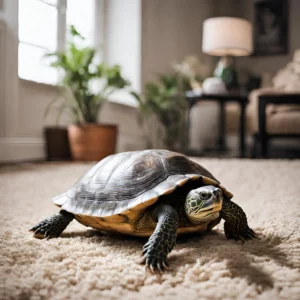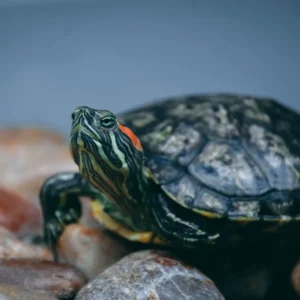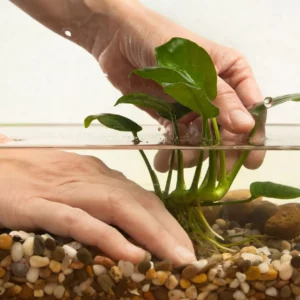Snails can make a great addition to the living environment for a turtle tank.
They:
- help in cleaning,
- water filtration,
- algae control,
- natural habitat imitation,
- and can make great companions for your shelled friend(s).
I’ve listed the seven best snails for turtle tank to help you find the right type for your turtle(s). Let’s check them out.
Best Snails for Turtle Tank
| Snails |
| Mystery Snail |
| Common Pond Snail |
| Black Devil Snail |
| Apple Snail |
| Rabbit Snail |
| Ramshorn Snail |
| Trumpet Snail |
Table of Contents
Mystery Snail
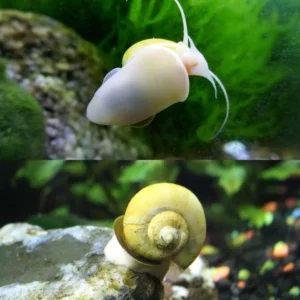
These little fellows are the most popular and active snails for turtle tanks. They have a vibrant splash of colors and love gliding across your turtle’s tank, munching on algae and leftover food like tiny vacuum cleaners.
Mystery snails typically grow to about the size of a golf ball, making them a safe choice for larger turtles who wouldn’t mistake them for a tasty snack.
They come in a dazzling array of colors:
- Yellow
- Ivory
- Chestnut
- Blue
- Jade
- Black
- Magenta
- Purple
They pose no threat to your turtle and can even share the tank with other peaceful fish and invertebrates due to their small to medium size and ‘’down-to-earth’’ nature.
Remember: Even though Mystery snails are bigger than other snail species, they’re still delicate creatures. Avoid potentially dangerous tank mates (typically any relatively large fish) and be mindful of water quality, as sudden changes in pH or ammonia spikes can harm them.
With proper care, these little algae-munching marvels can thrive alongside your turtle for a long time. They’re the perfect tiny sidekicks for your shelled friend, keeping your tank clean and adding a dash of personality to your underwater world.
| Characteristics | |
| Binomial name | Pomacea bridgesii |
| Family | Ampullariidae |
| Average lifespan | One to two years |
| Required temperature | 68~82°F/20~27.8°C |
| Required water pH | 6.5~7.5 |
Black Devil Snail
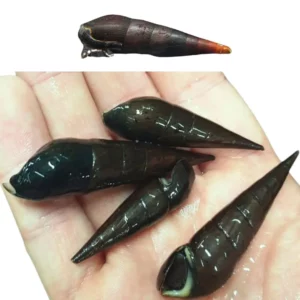
These dark snails are among the hardiest and longest-living species you can keep in your turtle tank. They grow large and feature gorgeous, glossy shells that range in dark colors – usually from chocolate brown to deep black.
Black Devil Snails possess a rather sizable shell, measuring up to 3.5 inches (8.9 cm) in length, although typically averaging around two to two and a half inches (5.1 – 6.4 cm). The average width of their shells ranges from ⅕ inch to ⅘ inch (0.25 to 0.5 cm).
These snails are known for their digging behavior and are active at night. They tend to spend most of their time in the substrate, maneuvering through it. This behavior helps them avoid the formation of potentially hazardous gas pockets, which could pose a threat to your pet.
Black Devil snails are native to brackish waters of Thailand but live in other parts of Asia. So, even though they can thrive in freshwater, they will only breed in brackish waters.
Pro tip: Due to breeding conditions/requirements, you should opt for more than a pair of Black Devils to provide your turtle with enough snails.
| Characteristics | |
| Binomial name | Faunus Ater |
| Family | Pachychilidae |
| Average lifespan | Up to six years |
| Required temperature | 71~82°F/21.7~27.8°C |
| Required water pH | 7.0~8.5 |
Common Pond Snails
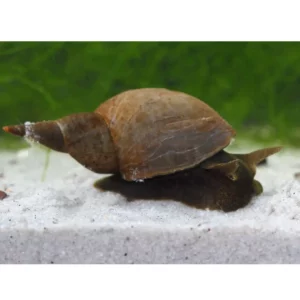
Common Pond snails, or Giant/Great Pond snails, are a widespread species originating from the European region. Today, they’re also located in America and Asia.
Pond snails possess conical shells that gradually narrow down and have wide openings. The shells exhibit regional variations in terms of shape and size.
The primary hue of the shells is a yellowish-brown shade, which can vary from light brown to dark brown. Occasionally, the shells may contain dark spots, although these distinctive markings are generally absent.
Also, unlike most other species, these snails have thick, triangular-shaped tentacles.
Pond snails have the potential to grow quite large. Based on various observations, their total length can range from one to three inches (2.5 – 7.6 cm).
In aquariums, however, they tend to be slightly smaller, reaching a maximum size of two inches (5.1 cm).
Due to their larger size compared to most other snails found in turtle tanks, common Pond snails are considered one of the safest options, as it’s unlikely that your turtle will consume them.
| Characteristics | |
| Binomial name | Lymnaea stagnalis |
| Family | Lymnaeidae (‘’Mud snails’’) |
| Average lifespan | Aproximatelly three years |
| Required temperature | 70~80°F/21.1~27.8°C |
| Required water pH | 7.0~7.5 |
Apple Snail
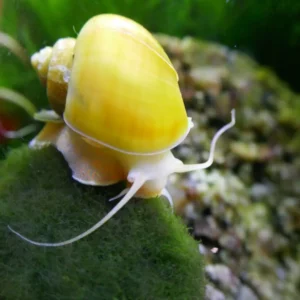
These snails are an excellent choice if you want a type that lives long enough, so you don’t have to worry about how often you should add or find new snails for your turtle’s tank, as they can live an entire decade!
Apple snails aren’t sensitive to lower temperatures like most other snails, meaning they’re great for turtles who enjoy a bit cooler environment – for example, the Painted turtle.
However, many see Apple snails and Mystery snails as the same species. While they come from the same family, they’re different animals with different personalities.
For example, their eating habits differ to some extent. Mystery snails are known to be avid plant-eaters and consume voraciously, while not all species of Apple snails share the same plant cravings.
Also, Apple snails and Mystery snails can be distinguished by the color of their feet. Mystery snails typically have either pure white or black feet, whereas Apple snails have olive green feet, a blend of light and dark shades.
Apple snails are beautiful, but before deciding to keep them, you need to consider how many plants your turtle has in their habitat and how big the tank is.
For instance, some Apple snail species are quite invasive and will eat your aquatic plants in no time if you’re not checking regularly. Also, they can grow large and may not be convenient for a small tank.
| Characteristics | |
| Binomial name | Pomacea bridgesii |
| Family | Ampullariidae |
| Average lifespan | Up to ten years |
| Required temperature | 64~82°F/17.8~27.8°C |
| Required water pH | About 7.0 |
Rabbit Snail
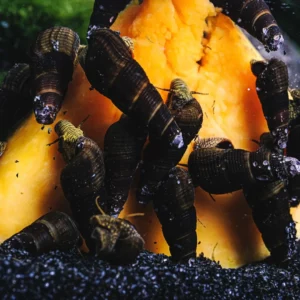
A Rabbit snail is a freshwater species with unique aesthetics due to its long shell and rabbit-like head – you can spot two drooping antennae on top of their head, resembling long rabbit ears.
Even though snails generally have sleek and jelly-like skin, the Rabbit Snail stands apart. Its body and face have wrinkles and a bit rougher texture.
But what makes them a common choice for turtle tanks, besides their distinguished appearance, is that they’re low-maintenance and incredibly active at cleaning.
The Rabbit Snail usually grows to three to five inches (7.6 to 12.7 cm) when fully matured. Initially, when you purchase/adopt them, they will be around two inches (5.1 cm) long.
These fascinating snails can grow super fast in the wild and in captivity. So, keep in mind that it won’t be long before they reach their maximum size!
| Characteristics | |
| Binomial name | Tylomelania |
| Family | Pachychilidae |
| Average lifespan | One to three years |
| Required temperature | About 76°F/24.4°C |
| Required water pH | About 8.0 |
Ramshorn Snail
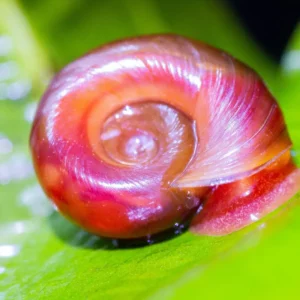
Ramshorn snails come in a variety of colors and patterns. The most popular colors on them are orange, brown, red, and blue. As for patterns, these are mostly random, but the most common one is a spotted pattern (often leopard-like).
When they’re young, Ramshorn snail shells are transparent, measuring approximately ¼ inches/0.6 cm in length.
But as the snails age, their shells become less transparent, meaning you can determine the age of Ramshorn snails by examining their shells. Also, as the snail grows longer, their shells widen.
These snails are another good example of fast-cleaning snails to keep in your turtle’s habitat. But they have a bit more specific diet.
The Ramshorn snail makes a tank look cleaner by eating up whatever has been rejected by your turtle. While they enjoy nibbling on algae and plants from time to time, they mostly feed on decayed plants, insects, leftovers, and other debris that your turtle has no use for anymore.
| Characteristics | |
| Binomial name | Planorbarius corneus |
| Family | Planorbidae |
| Average lifespan | One to three years |
| Required temperature | About 75°F/23.9°C |
| Required water pH | 7.0~8.0 |
Trumpet Snail
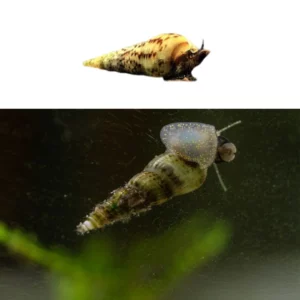
Trumpet snails, also known as red-rimmed Melania snails or Malaysian Trumpet snails, are short-living snails. They usually live less than a year, but in some cases, they can reach the one-year mark.
The usual sizes for trumpets range from 0.25 to 0.5 inches. In nature, trumpets rarely grow larger than one inch, but if they have the perfect conditions in captivity, they can reach a maximum size of approximately two inches.
But what makes the Trumpet species a bit different is their gender distinction, as female snails tend to be longer than their male counterparts.
Trumpets are easily recognizable due to their cone-shaped shells, with a rough texture formed by rings encircling the shell from top to bottom. While there are all kinds of color variations, the most common shell colors for Trumpets are:
- grey,
- cream,
- brown,
- and white.
| Characteristics | |
| Binomial name | Melanoides tuberculata |
| Family | Thiaridae |
| Average lifespan | Up to a year |
| Required temperature | 72~80°F/22.2~27.8°C |
| Required water pH | About 7.5 |
Benefits of Keeping Snails In a Turtle Tank
- Tank cleaning: Snails can be great tank mates for all types of pet turtles as they help clean the tank by consuming organic debris and garbage. Their diligent cleaning behavior contributes to maintaining a healthier aquatic environment, benefiting the turtles and the overall tank ecosystem.
- Algae control: Snails are useful for aesthetic purposes and tank maintenance, as they actively search for and consume various forms of algae. This helps control algae growth, preventing it from becoming an issue in the turtle tank.
- Potential companionship (tank mates): Large snails are less likely to be eaten by turtles, making them suitable tank mates. Keeping larger snails in the aquarium can lead to better cohabitation with turtles, providing a balanced ecosystem.
- Natural habitat imitation: Being surrounded by snails, besides aquatic plants for turtle tank and small fish, helps mimic the natural habitat of your turtle. This can provide your shelled companion with co-habitants that encourage exploration, foraging, playing, hiding, and other instinctive behaviors.
So, keeping the right type of snails in your turtle tank will help them feel comfortable (at home) and encourage mental and physical stimulation.
Vet Q&A
Are snails bad for my tank?
The simple answer is no – snails aren’t bad for your tank. But it’s important to know that even though there are no “bad” snails per se, some species like Ramshorn have the potential to reproduce rapidly and overwhelm an aquarium.
Many of these tiny creatures taking over your turtle’s tank can be unsettling, and they can also disrupt the biological filtration process and block filter intake tubes.
On the other hand, this rarely happens, so you shouldn’t worry about it, as long as you consult an expert aquarist.
Will turtles eat my snails?
There’s no specific answer since whether your turtle will eat snails depends on different factors. For instance, your turtle may eat snails:
- If they feel particularly hungry and happen to be nearby
- If you keep quite small snail species that are often a part of turtle’s diet in their natural habitat
- If you have a carnivore/omnivor turtle species that tend to have a bit more territorial personality
Remember: These are some of the most common factors, so it’s never possible to know whether your turtle will eat your snails.
What snails will turtles not eat?
Pet turtles don’t tend to eat larger snails. Most turtles are omnivores, and the food that pet turtles eat includes snails, just like their cousins that live in the wild.
However, if you keep a large enough snail (common Pond snail, for example), you won’t have to worry about your turtle eating them as they may be too big for most turtles.
My Senior Paws is a participant in the Amazon Services LLC Associates Program, an affiliate advertising program designed to provide a means for sites to earn advertising fees by advertising and linking to Amazon.com. We also participate in other affiliate programs which compensate us for referring traffic.


